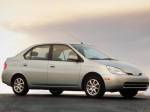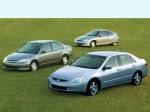History of the Hybrid

In Ontario, Canada, in 1914 the Galt Motor Company rolled out the Galt Gas Electric, a pure series hybrid that featured a two-cylinder, two-stroke engine of 10 horsepower driving a 40-volt, 90-amp Westinghouse generator. It was claimed the Galt could wring 70 miles from one gallon of gasoline or, alternately, do 15 to 20 miles on the battery alone. But a top speed of about 30 mph sent potential buyers to more powerful, speedier alternatives. What is almost certainly the last remaining Galt Gas Electric now rests in the Canadian Automotive Museum in Oshawa.
 1978 Marathon Electric Car
1978 Marathon Electric Car
|
Much later, Briggs & Stratton joined up with Marathon Electric Car, a builder of electric golf carts and other vehicles. The Briggs & Stratton was based on the Marathon C-360 delivery van, an odd device with two rear axles, the forward to provide drive, the rear (called a "captive trailer") to help carry the considerable weight of the battery pack of 12 lead-acid six-volt batteries weighing 66 pounds each. In the nose went a Briggs & Stratton two-cylinder opposed, air-cooled engine of 18 horsepower, paired with a Baldor electric motor of 20 horsepower. According to reports, the dual rear axles contributed to some unusual handling characteristics, particularly when in reverse or negotiating tight corners, and the drivetrain was prone to failures.
While automotive development of hybrids has been sporadic, hybrid technology has gained enormous favor in other applications. For example, for decades much of the world's really big earth-moving equipment has utilized diesel-electric hybrid powertrains, much like Porsche's layout for Lohner. And diesel-electric locomotives, at least in North America, pull most of the railroad traffic. In a sense, these can be thought of as diesel powered, with an electrical transmission system to turn the wheels.
For automotive use, however, hybrids, as with da Vinci's flying machine, have been looking for their time. And during the waning days of the 20th century, that time finally arrived. Toyota's Prius went on sale in Japan in 1997, making it the world's first volume production hybrid car. The practical five-passenger Prius has since become by far the world's most popular hybrid with current total sales-it's now sold in 20 countries-totaling over 110,000 units. It went on sale in North America as a 2000 model with an endearing combination of "normal car" functionality and impressive fuel economy.
 1997 Toyota Prius
1997 Toyota Prius
|
The first-generation Prius that sold in the United States matched a 1.5-liter, four-cylinder gasoline engine of 70 horsepower with a 44-horsepower electric motor and utilized a separate generator to keep the battery pack charged up, so it didn't have to be plugged in. During braking, the electric motor also acted as a generator to recapture energy and further charge the batteries. That means that even in stop-and-go city driving, the Prius was amazingly efficient, and could go an estimated 52 miles on a gallon of gas. The Prius was a true hybrid, in that it could operate on the gas engine only, the electric motor only, or on a combination of both.
Other hybrids include the Honda Insight, first sold in America as a 2000 model, and the Honda Civic Hybrid, which came to market in the U.S. as a 2003 model. A variation of the Civic sedan, the Civic Hybrid is a mild hybrid, meaning that the electric motor assists the gasoline engine during acceleration or times of heavy load, but doesn't move the car on its own.
 Honda's hybrid range
Honda's hybrid range
|
The second-generation Prius, launched for the 2004 model year, has a 78-horsepower gasoline engine and 67-horsepower electric motor that works together in what Toyota calls "Hybrid Synergy Drive." The system is capable of operating in either the gasoline or electric modes separately, or with both the gasoline engine and electric motor in operation at the same time. One of the more significant aspects of the 2004 Prius is that it offers the interior room of the midsize category sedan, thus making it a practical alternative for carrying more passengers or cargo.
Toyota will offer a hybrid version of its popular midsize sport utility vehicle (SUV), the Highlander, while Lexus will launch a hybrid version of its popular RX 330 luxury utility vehicle, the RX 400h, both in 2005. The hybrid RX will utilize a version of Hybrid Synergy Drive with front and rear electric motors and a front mounted V6 internal combustion engine. This combination is expected to create the power and torque of a V8 and deliver the fuel mileage of a compact car while producing a fraction of the emissions of standard SUVs.
 1996 GM EV-1
1996 GM EV-1
|
Honda is offering a hybrid Accord as its flagship midsize model, offering 15 horsepower more than the standard Accord V6 model's 240 horsepower, but touting the fuel efficiency of a four-cylinder. On the American front, Ford has introduced the world's first hybrid SUV in the form of the Escape Hybrid, while Chevrolet is selling a very mild hybrid version of the Silverado pickup truck. While these offer only marginal benefits, they are a step in the right direction, after the debacle that was the GM EV-1.
 Crushed GM EV-1 cars
Crushed GM EV-1 cars
|
General Motors produced about 1,100 of the purely electric two-seater EV-1 cars from 1996 to 1999, to meet tough emissions regulations in states such as California. Because the EV1's technology was considered experimental, the company leased the cars to drivers instead of selling them. But the California Air Resources Board relaxed automobile-emissions requirements. GM, claiming efforts to market the car were a dismal and costly failure, then pulled the plug on the EV1 and began reclaiming the cars. All cars were then destroyed, in what was considered by critics as a conspiracy to keep gasoline-powered vehicles on showroom floors while keeping oil barons happy. However, companies such as Toyota and Honda are now leading the way in environmentally-friendly cars, using hybrid technology to bridge the gap between gasoline-powered and electric cars.
Though it's taken a century for the concept of a practical hybrid car to become a reality, it's clear that the hybrid has, at last, found its time. Thanks to the improvement in hybrid system technology, the increased concerns surrounding our environment and the relatively limited supply of fossil fuels, hybrid cars are closer to mainstream than ever before.
Back to Features
Page 1 2
|
|
|
History of the Hybrid
They've Been Around Longer Than You May Think
Page 1
Page 2
|
|
|